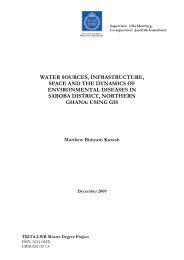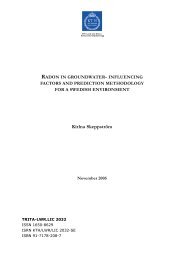Comparison between 1D and 2D models to analyze the dam break
Comparison between 1D and 2D models to analyze the dam break
Comparison between 1D and 2D models to analyze the dam break
- No tags were found...
You also want an ePaper? Increase the reach of your titles
YUMPU automatically turns print PDFs into web optimized ePapers that Google loves.
Ignacio Valcárcel LencinaTRITA LWR Masters ThesisThe simulation clearly shows <strong>the</strong> influence of <strong>the</strong> bed’s<strong>to</strong>pography on <strong>the</strong> elevation of <strong>the</strong> water surface.Comparing <strong>the</strong>se results with those obtained from <strong>the</strong>model with flat bot<strong>to</strong>m <strong>to</strong>pography, <strong>the</strong> influence of<strong>the</strong> <strong>to</strong>pography is proved.Figure 17d. Water surface at t = 5.4 s. Model with flatbot<strong>to</strong>m <strong>to</strong>pography.The <strong>to</strong>tal computation time for this model has been 59s, eight seconds faster than <strong>the</strong> previous model;obviously <strong>the</strong> complexity of this model is different.Figure 17a. Water surface at t = 0 s. Model with flat bot<strong>to</strong>m<strong>to</strong>pography.4. - VALIDATION OF TH E <strong>1D</strong> MODELIn general, validation is <strong>the</strong> process of checking ifsomething satisfies a certain criterion. At this point, itis needed <strong>to</strong> check if <strong>the</strong> results are satisfac<strong>to</strong>ry or not.It will be done comparing <strong>the</strong> solution obtained withComsol Multiphysics (CM) with o<strong>the</strong>r solutions of <strong>the</strong>same problem.The definition sketch of <strong>the</strong> model that we comparewith is <strong>the</strong> figure below:Figure 17b. Water surface at t = 2.7 s. Model with flatbot<strong>to</strong>m <strong>to</strong>pography.Figure 17c. Water surface at t = 4 s. Model with flat bot<strong>to</strong>m<strong>to</strong>pography.Figure 18. Definition sketch of <strong>the</strong> model for <strong>the</strong> validation.A wide, horizontal, rectangular <strong>and</strong> frictionlesschannel is used <strong>to</strong> simulate <strong>the</strong> <strong>dam</strong>-<strong>break</strong> flow. Attime t = 0 + , <strong>the</strong> <strong>dam</strong> is removed instantly. The nexttwo figures below show that <strong>the</strong> most similar solutionof <strong>the</strong> model solved with CM is <strong>the</strong> analytical. In thissolution we observe that <strong>the</strong> wave front is almostvertical (both upstream <strong>and</strong> downstream of <strong>the</strong> <strong>dam</strong>),which is very close <strong>to</strong> our solution. The o<strong>the</strong>rsolutions are also similar. By comparison with <strong>the</strong> fivesolutions given by Rahman <strong>and</strong> Chaudhry (1997), weconclude that <strong>the</strong> code is satisfac<strong>to</strong>ry valid <strong>to</strong> solve <strong>the</strong><strong>1D</strong> <strong>dam</strong>-<strong>break</strong> flow.The analytical <strong>dam</strong> <strong>break</strong> solution is given by Ritter in1892. This solution is:2 ⎛ x⎜ + c3 ⎝ t=0⎞⎟⎠u (13)12
















